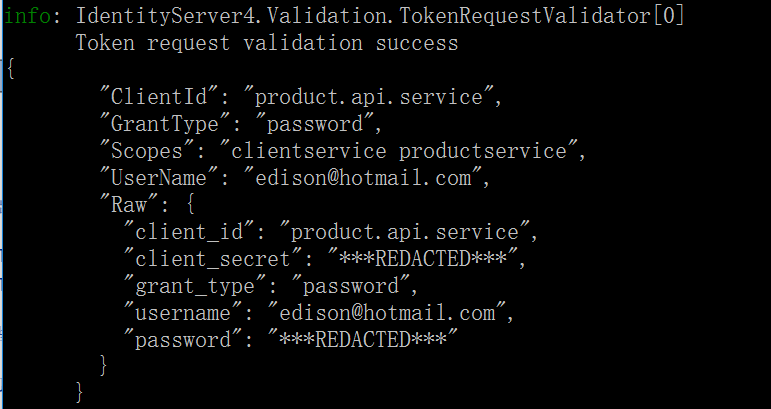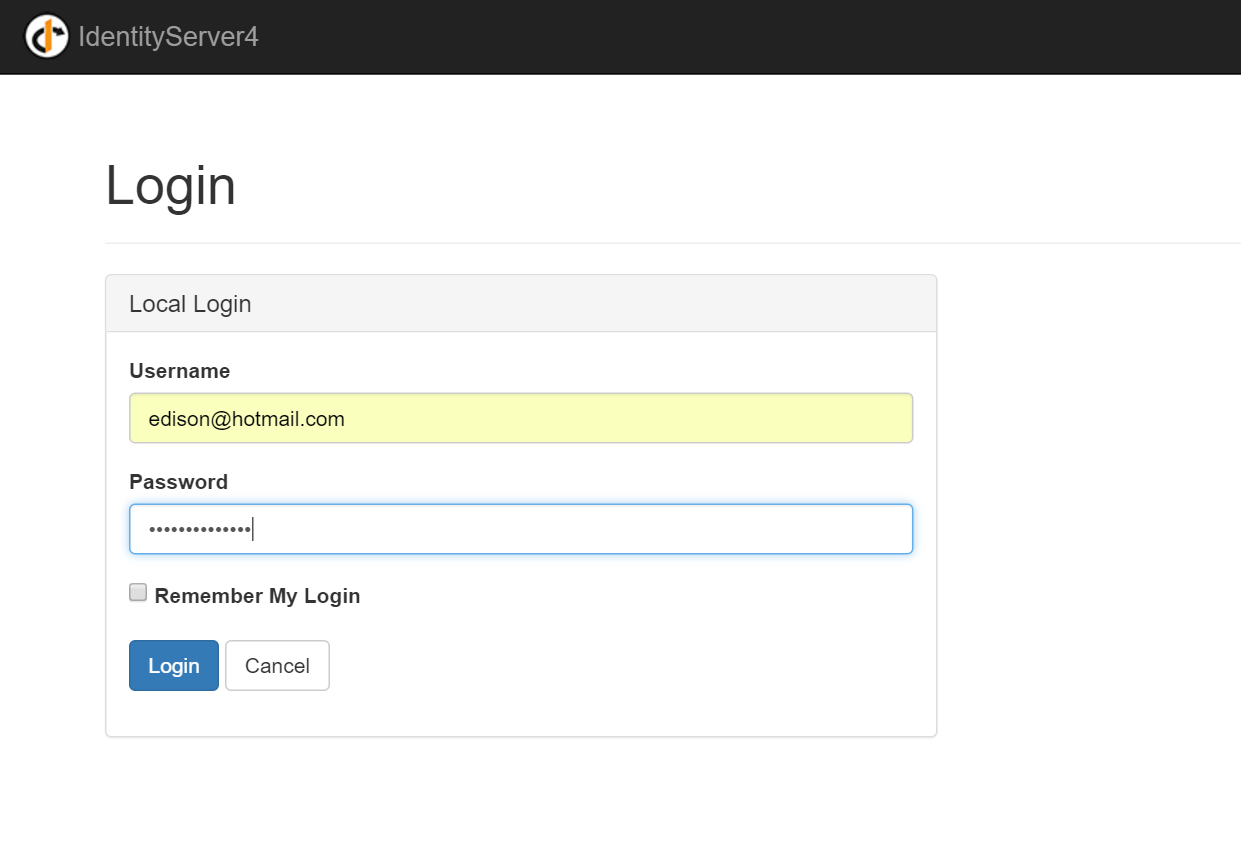.NET Core微服务之基于IdentityServer建立授权与验证服务
Tip: 此篇已加入.NET Core微服务基础系列文章索引
一、IdentityServer的预备知识

要学习IdentityServer,事先得了解一下基于Token的验证体系,这是一个庞大的主题,涉及到Token,OAuth&OpenID,JWT,协议规范等等等等,园子里已经有很多介绍的文章了,个人觉得solenovex的这一篇文章《学习IdentityServer4的预备知识》言简意赅,可以快速的看看。另外savaboard的《ASP.NET Core 之 Identity 入门(一)》和《ASP.NET Core 之 Identity 入门(二)》这两篇也可以一看,对Claims和Identity的基本知识讲的比较通俗易懂,深入浅出,有故事情节,哈哈。

重点关注一下上面这张图(也是来自solenovex的文章),对于一个User(已注册)来说,他会首先向Authorization Server表明自己的身份(比如输入用户名和密码),然后Authorization Server为其发放了一个token,而这个token就好比是把家里的钥匙配了一把(clone)新的,此后该User就可以访问API请求获取Orders(订单)数据了。当然,实际中可能Authorization Server和API Server不在同一个区域内,它们可能只能遥望对方。此外,User还可以基于这个token去访问第三方服务,第三方服务会使用这个API来访问API Server,向其提供token比提供username&password要安全得多。
二、IdentityServer极简介绍
IdentityServer4(这里只使用版本号为4)是一个基于OpenID Connect和OAuth 2.0的针对ASP.NET Core 2.0的框架。IdentityServer是将规范兼容的OpenID Connect和OAuth 2.0终结点添加到任意ASP.NET Core应用程序的中间件。通常,你构建(或重新使用)包含登录和注销页面的应用程序,IdentityServer中间件会向其添加必要的协议头,以便客户端应用程序可以使用这些标准协议与其对话。

我们可以用IdentityServer来做啥?
(1)身份验证服务=>官方认证的OpenID Connect实现
(2)单点登录/注销(SSO)
(3)访问受控的API=>为不同的客户提供访问API的令牌,比如:MVC网站、SPA、Mobile App等
(4)等等等......
三、Started:第一个AuthorizationServer
1.1 建立一个ASP.NET Core空Web项目
建立ASP.NET Core项目,使用Empty空模板。
为了更好地查看日志信息,同时考虑到IISExpress启动起来真的很慢,修改lanuchSettings.json文件如下:
{ "profiles": { "Manulife.DNC.MSAD.IdentityServer4Test": { "commandName": "Project", "launchBrowser": false, "environmentVariables": { "ASPNETCORE_ENVIRONMENT": "Development" }, "applicationUrl": "http://localhost:5000/" } } }
1.2 安装并配置IdentityServer4
Step1.首先安装IdentityServer4:
NuGet>Install-Package IdentityServer4
Step2.配置ASP.NET Core管道,即修改Configure方法
public void Configure(IApplicationBuilder app, IHostingEnvironment env) { if (env.IsDevelopment()) { app.UseDeveloperExceptionPage(); } app.UseIdentityServer(); }
Step3.为了要把IdentityServer注册到容器中,需要对其进行配置,而这个配置中要包含三个信息:
(1)哪些API可以使用这个AuthorizationServer
(2)哪些Client可以使用这个AuthorizationServer
(3)哪些User可以被这个AuthrizationServer识别并授权
这里为了快速演示,我们写一个基于内存的静态类来快速填充上面这些信息(实际中,可以持久化在数据库中通过EF等ORM获取,也可以通过Redis获取):
public class InMemoryConfiguration { public static IConfiguration Configuration { get; set; } /// <summary> /// Define which APIs will use this IdentityServer /// </summary> /// <returns></returns> public static IEnumerable<ApiResource> GetApiResources() { return new[] { new ApiResource("clientservice", "CAS Client Service"), new ApiResource("productservice", "CAS Product Service"), new ApiResource("agentservice", "CAS Agent Service") }; } /// <summary> /// Define which Apps will use thie IdentityServer /// </summary> /// <returns></returns> public static IEnumerable<Client> GetClients() { return new[] { new Client { ClientId = "client.api.service", ClientSecrets = new [] { new Secret("clientsecret".Sha256()) }, AllowedGrantTypes = GrantTypes.ResourceOwnerPasswordAndClientCredentials, AllowedScopes = new [] { "clientservice" } }, new Client { ClientId = "product.api.service", ClientSecrets = new [] { new Secret("productsecret".Sha256()) }, AllowedGrantTypes = GrantTypes.ResourceOwnerPasswordAndClientCredentials, AllowedScopes = new [] { "clientservice", "productservice" } }, new Client { ClientId = "agent.api.service", ClientSecrets = new [] { new Secret("agentsecret".Sha256()) }, AllowedGrantTypes = GrantTypes.ResourceOwnerPasswordAndClientCredentials, AllowedScopes = new [] { "agentservice", "clientservice", "productservice" } } }; } /// <summary> /// Define which uses will use this IdentityServer /// </summary> /// <returns></returns> public static IEnumerable<TestUser> GetUsers() { return new[] { new TestUser { SubjectId = "10001", Username = "edison@hotmail.com", Password = "edisonpassword" }, new TestUser { SubjectId = "10002", Username = "andy@hotmail.com", Password = "andypassword" }, new TestUser { SubjectId = "10003", Username = "leo@hotmail.com", Password = "leopassword" } }; } }
Step4.对于Token签名需要一对公钥和私钥,不过IdentityServer为开发者提供了一个AddDeveloperSigningCredential()方法,它会帮我们搞定这个事,并默认存到硬盘中。当切换到生产环境时,还是得使用正儿八经的证书,更换为使用AddSigningCredential()方法。
public void ConfigureServices(IServiceCollection services) { InMemoryConfiguration.Configuration = this.Configuration; services.AddIdentityServer() .AddDeveloperSigningCredential() .AddTestUsers(InMemoryConfiguration.GetUsers().ToList()) .AddInMemoryClients(InMemoryConfiguration.GetClients()) .AddInMemoryApiResources(InMemoryConfiguration.GetApiResources()); }
1.3 获取你心心念念的Token
Step1.启动刚刚我们建立的AuthorizationServer程序,这里我们绑定的是5000端口。
Step2.启动Postman/SoapUI等API测试工具,通过向HTTP Body中填写数据发起POST请求:


Step3.发送一个错误的数据,看看返回的是啥?(这里输入了一个不在定义列表中的client_id)

Step4.查看控制台的日志信息:表示获取Token的这个请求成功了,日志中client_secret和password都是不会直接明文显示的。

Step5.IdentityServer中我们设置这几个API Service的Grant_Type是ResourceOwnerPasswordAndClientCredentials(点击这里了解=>资源拥有者密码凭据许可),因此我们还可以使用ClientCredentials(点击这里了解=>客户端凭据许可),如下所示:

Step6.再次查看控制台日志信息:这次没有关于User相关的任何信息显示了。

Step7.基本的开发结束,对于开发阶段,我们使用IdentityServer为开发者提供的临时证书即可,但是后面仍然需要生成一些正儿八经的证书。这里我们通过OpenSSL来生成,首先去官网下载一个,这里使用的是Win64_1.1版本。打开Powershell或者CMD,输入以下命令:
cmd>openssl req -newkey rsa:2048 -nodes -keyout cas.clientservice.key -x509 -days 365 -out cas.clientservice.cer
下面将生成的证书和Key封装成一个文件,以便IdentityServer可以使用它们去正确地签名tokens
cmd>openssl pkcs12 -export -in cas.clientservice.cer -inkey cas.clientservice.key -out cas.clientservice.pfx
中途会提示让你输入Export Password,这个password后面会用到,记住它。最终导出后的结果如下图所示:

这里我将其放到了项目结构文件夹中,并设置这个pfx文件为“如果较新则复制”,确保可以在最后生成的目录里边。现在就可以修改一下ConfigureServices()方法了:
public void ConfigureServices(IServiceCollection services) { var basePath = PlatformServices.Default.Application.ApplicationBasePath; InMemoryConfiguration.Configuration = this.Configuration; services.AddIdentityServer() //.AddDeveloperSigningCredential() .AddSigningCredential(new X509Certificate2(Path.Combine(basePath, Configuration["Certificates:CerPath"]), Configuration["Certificates:Password"])) .AddTestUsers(InMemoryConfiguration.GetUsers().ToList()) .AddInMemoryClients(InMemoryConfiguration.GetClients()) .AddInMemoryApiResources(InMemoryConfiguration.GetApiResources()); }
这里我将证书的路径和导出密码都写到了配置文件中:

{ "Certificates": { "CerPath": "certificate\\cas.clientservice.pfx", "Password": "manulife" } }
好,配置正儿八经的证书这一步骤Over。
四、IdentityServer QuickStart-UI
4.1 关于QuickStart UI
IdentityServer为我们提供了一套UI以便使我们能够快速地开发具有基本功能的认证/授权界面,我们可以去这个地址:https://github.com/IdentityServer/IdentityServer4.Quickstart.UI/tree/release 下载,并将其复制到我们的项目目录中。

复制完成后,我们的项目结构如下图所示:

4.2 修改DI方法
(1)使用MVC与静态文件(由于wwwroot下有很多静态资源文件)
public void Configure(IApplicationBuilder app, IHostingEnvironment env) { if (env.IsDevelopment()) { app.UseDeveloperExceptionPage(); } app.UseIdentityServer(); // for QuickStart-UI app.UseStaticFiles(); app.UseMvcWithDefaultRoute(); }
(2)注册MVC
public void ConfigureServices(IServiceCollection services) { var basePath = PlatformServices.Default.Application.ApplicationBasePath; InMemoryConfiguration.Configuration = this.Configuration; services.AddIdentityServer() //.AddDeveloperSigningCredential() .AddSigningCredential(new X509Certificate2(Path.Combine(basePath, Configuration["Certificates:CerPath"]), Configuration["Certificates:Password"])) .AddTestUsers(InMemoryConfiguration.GetUsers().ToList()) .AddInMemoryClients(InMemoryConfiguration.GetClients()) .AddInMemoryApiResources(InMemoryConfiguration.GetApiResources()); // for QuickStart-UI services.AddMvc(); }
4.3 Run
(1)首页(这里由于我已经登录,所以这里会把我的账号显示了出来)

(2)Logout页,刚刚说到我已经实现Login了,所以我这里Logout一下


(3)Login页:这里只能识别我们在之前配置的静态User列表中那些User

登录之后,显示:"You have not given access to any applications",表示我们还没有给他授予访问任何API或网站模块的权限。后续我们会创建API和MVC网站来演示如何对其进行授权和访问。

五、小结
本篇主要简单的介绍了IdentityServer以及如何基于IdentityServer建立一个基本的AuthorizationServer,如何获取Token,以及集成QuickStart UI实现基本的界面展示。后续还会创建API和MVC网站,来和IdentityServer进行集成,以演示如何对User授予访问API和MVC网站的访问权限。
示例代码
Click => https://github.com/EdisonChou/EDC.IdentityServer4.Demo
参考资料
《identityserver4官方文档》=> 重点关注那些流程图与术语
ddrsql,《IdentityServer4之Resource Owner Password Credentials(资源拥有者密码凭据许可)》
ddrsql,《IdentityServer4之Client Credentials(客户端凭据许可)》
solenovex,《学习Identity Server4的预备知识》
solenovex,《使用Identity Server 4建立Authorization Server (1)》
solenovex,《使用Identity Server 4建立Authorization Server (2)》
solenovex,《使用Identity Server 4建立Authorization Server (3)》









【推荐】国内首个AI IDE,深度理解中文开发场景,立即下载体验Trae
【推荐】编程新体验,更懂你的AI,立即体验豆包MarsCode编程助手
【推荐】抖音旗下AI助手豆包,你的智能百科全书,全免费不限次数
【推荐】轻量又高性能的 SSH 工具 IShell:AI 加持,快人一步
· 开发者必知的日志记录最佳实践
· SQL Server 2025 AI相关能力初探
· Linux系列:如何用 C#调用 C方法造成内存泄露
· AI与.NET技术实操系列(二):开始使用ML.NET
· 记一次.NET内存居高不下排查解决与启示
· Manus重磅发布:全球首款通用AI代理技术深度解析与实战指南
· 被坑几百块钱后,我竟然真的恢复了删除的微信聊天记录!
· 没有Manus邀请码?试试免邀请码的MGX或者开源的OpenManus吧
· 园子的第一款AI主题卫衣上架——"HELLO! HOW CAN I ASSIST YOU TODAY
· 【自荐】一款简洁、开源的在线白板工具 Drawnix
2015-06-23 数据结构基础温故-1.线性表(上)